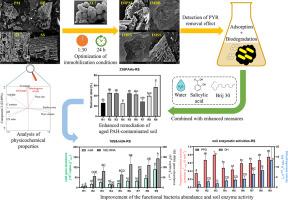Characterization and PAH removal performance of microbe-immobilized biochars derived from different feedstocks
IF 6.3
2区 环境科学与生态学
Q1 ENVIRONMENTAL SCIENCES
引用次数: 0
Abstract
Microbial degradation is the primary mechanism for purifying polycyclic aromatic hydrocarbon (PAH) contamination in environments, and biochar immobilization is an effective technology to enhance biodegradation, but the process parameters of the immobilization technology still require further systematic evaluation. Here, biochars derived from pig manure (PM), bamboo (BB), rice straw (RS), and soybean straw (SS) were used as carriers of Mycobacterium sp. ZL7, and the optimal biochar dosage of 1:30 (w/V) and immobilization time of 24 h were determined. The immobilization effects followed the order of RS > SS > PM > BB. Scanning electron microscopy and physicochemical properties revealed that porous structures acted as shelters for bacteria, and high nitrogen content, large pore size and high-water holding capacity played important driving roles in immobilization. In the single-substrate system, pyrene removal rates of the PM-, RS- and SS-immobilized materials were greater than 96 %, which were significantly higher than those of the biochar alone or the free strain. An orthogonal design experiment in historically PAH-contaminated soil further revealed that, compared with free strains, immobilized materials combined with high moisture content and moderate salicylic acid or Brij 30 can effectively increase the abundance of bacteria and the nidA gene, and enhance the dehydrogenase and polyphenol oxidase activities. The removal rate of total PAHs increased by 8.53 %-30.45 % after 24 d. Moreover, biochar with strong immobilization capacity showed better PAH removal effects. This study provides a scientific basis and practical reference for biochar-immobilized microorganisms to enhance the self-purification of PAH-contaminated soil.

不同原料微生物固定化生物炭的表征及去除多环芳烃的性能
微生物降解是环境中多环芳烃(PAH)污染净化的主要机制,生物炭固定化是增强生物降解的有效技术,但固定化技术的工艺参数仍需进一步系统评价。以猪粪(PM)、竹子(BB)、稻草(RS)和大豆秸秆(SS)为载体,确定了最佳生物炭投加量为1:30 (w/V),固定化时间为24 h。固定效果依次为RS >; SS > PM >; BB。扫描电镜和理化性质分析表明,多孔结构对细菌具有庇护作用,高氮含量、大孔径和高持水量对细菌的固定起重要作用。在单底物体系中,PM-、RS-和ss -固定化材料对芘的去除率均大于96%,显著高于生物炭或游离菌的去除率。在历史多环芳烃污染土壤中进行的正交设计试验进一步表明,与游离菌株相比,高含水量和适度水杨酸或Brij 30结合的固定化材料可以有效增加细菌和nidA基因的丰富度,提高脱氢酶和多酚氧化酶的活性。24 d后对总多环芳烃的去除率提高了8.53% ~ 30.45%,且固定化能力强的生物炭对多环芳烃的去除率较好。本研究为生物炭固定化微生物提高多环芳烃污染土壤的自净化能力提供了科学依据和实用参考。
本文章由计算机程序翻译,如有差异,请以英文原文为准。
求助全文
约1分钟内获得全文
求助全文
来源期刊

Journal of Environmental Sciences-china
环境科学-环境科学
CiteScore
13.70
自引率
0.00%
发文量
6354
审稿时长
2.6 months
期刊介绍:
The Journal of Environmental Sciences is an international journal started in 1989. The journal is devoted to publish original, peer-reviewed research papers on main aspects of environmental sciences, such as environmental chemistry, environmental biology, ecology, geosciences and environmental physics. Appropriate subjects include basic and applied research on atmospheric, terrestrial and aquatic environments, pollution control and abatement technology, conservation of natural resources, environmental health and toxicology. Announcements of international environmental science meetings and other recent information are also included.
 求助内容:
求助内容: 应助结果提醒方式:
应助结果提醒方式:


